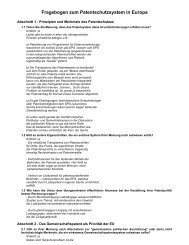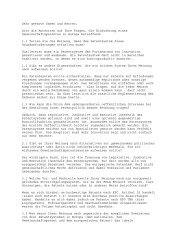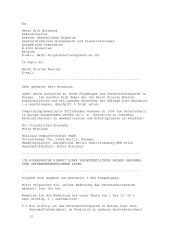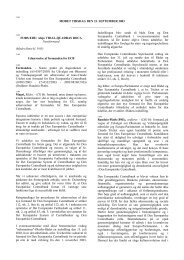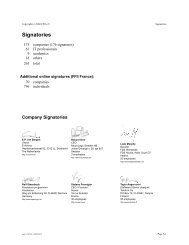EUROPEAN COMMISSION Brussels, 09/01/06 Questionnaire On ...
EUROPEAN COMMISSION Brussels, 09/01/06 Questionnaire On ...
EUROPEAN COMMISSION Brussels, 09/01/06 Questionnaire On ...
You also want an ePaper? Increase the reach of your titles
YUMPU automatically turns print PDFs into web optimized ePapers that Google loves.
<strong>EUROPEAN</strong> <strong>COMMISSION</strong><br />
Internal Market and Services DG<br />
Knowledge-based Economy<br />
Industrial property<br />
<strong>Questionnaire</strong><br />
<strong>Brussels</strong>, <strong>09</strong>/<strong>01</strong>/<strong>06</strong><br />
<strong>On</strong> the patent system in Europe<br />
EN EN
INTRODUCTION<br />
The field of intellectual property rights has been identified as one of the seven cross-sectoral<br />
initiatives for the Union's new industrial policy as set out in the Commission Communication<br />
launched on 5 October 2005. Stimulating growth and innovation means improving the<br />
framework conditions for industry, which include an effective IPR system.<br />
In 1997, the Commission launched the idea of a Community Patent in its Green Paper on<br />
promoting innovation. This was taken up by Heads of State and Government in the<br />
conclusions of the Lisbon European Council of March 2000, who called for a Community<br />
patent to be available by the end of 20<strong>01</strong>. The Community Patent proposal, establishing a<br />
unitary system of patent protection for the single market, has formally been on the table of the<br />
Council since 2000 but overall agreement is yet to be achieved. The Commission remains<br />
convinced that an affordable Community Patent would offer the greatest advantages for<br />
business: we owe it to industry, investors and researchers to have an effective patent regime in<br />
the EU. Commissioner McCreevy has stated his intention to make one final effort to have the<br />
proposal adopted during his mandate. Until the time and conditions are ripe for that effort,<br />
the interim period should be used to seek views of stakeholders on en effective IPR system in<br />
the EU.<br />
Views are therefore sought on the patent system in Europe, and what changes if any are<br />
needed to improve innovation and competitiveness, growth and employment in the<br />
knowledge-based economy.<br />
Please note that this consultation focuses on the overall legal framework. Accompanying<br />
measures, such as information, awareness raising or support training, are outside the scope of<br />
consultation.<br />
The document that follows contains a number of questions: In answering them we would<br />
invite you to be as detailed as you can. Supporting evidence and statistics are also welcome.<br />
<strong>On</strong> the basis of the feedback the Commission intends to organise a hearing in <strong>Brussels</strong> in<br />
early summer 20<strong>06</strong>.<br />
This consultation is open to all, and will be closed on 31 March 20<strong>06</strong>.<br />
The Commission services will publish a report on the outcome of this consultation. It will be<br />
available on the Internal Market and Services Directorate's General website.<br />
Please either email us at:<br />
Markt-D2-patentstrategy@cec.eu.int<br />
Or send your response by post to:<br />
Mr Erik Nooteboom<br />
Head of Unit<br />
Industrial Property Unit<br />
Internal Market and Services Directorate General<br />
European Commission<br />
1049 <strong>Brussels</strong><br />
Belgium<br />
PRIVACY STATEMENT<br />
EN 1 Error! Unknown document property name. EN
Please be sure to indicate if you do not consent to the publication of your personal data or<br />
data relating to your organisation with the publication of your response.<br />
The contact data provided by the stakeholder make it possible to contact the stakeholder to<br />
request a clarification if necessary on the information supplied.<br />
By responding to this consultation you automatically give permission to the Commission to<br />
publish your contribution unless your opposition to publish your contribution is explicitly<br />
stated in your reply. The Commission is committed to user privacy and details on the personal<br />
data protection policy can be accessed at:<br />
http://europa.eu.int/geninfo/legal_notices_en.htm#personaldata<br />
For further information please contact Ms Grazyna PIESIEWICZ at<br />
grazyna.piesiewicz@cec.eu.int or at +32.2.298.<strong>01</strong>.24.<br />
EN 2 Error! Unknown document property name. EN
Section 1 - Basic principles and features of the patent system<br />
The idea behind the patent system is that it should be used by businesses and research<br />
organisations to support innovation, growth and quality of life for the benefit of all in society.<br />
Essentially the temporary rights conferred by a patent allow a company a breathing-space in<br />
the market to recoup investment in the research and development which led to the patented<br />
invention. It also allows research organisations having no exploitation activities to derive<br />
benefits from the results of their R&D activities. But for the patent system to be attractive to<br />
its users and for the patent system to retain the support of all sections of society it needs to<br />
have the following features:<br />
– clear substantive rules on what can and cannot be covered by patents,<br />
balancing the interests of the right holders with the overall objectives of the<br />
patent system<br />
– transparent, cost effective and accessible processes for obtaining a patent<br />
– predictable, rapid and inexpensive resolution of disputes between right<br />
holders and other parties<br />
– due regard for other public policy interests such as competition (anti-trust),<br />
ethics, environment, healthcare, access to information, so as to be effective and<br />
credible within society.<br />
1.1 Do you agree that these are the basic features required of the patent system?<br />
The fundamental purpose of the patent system is to encourage and support<br />
innovation. The exclusive rights it provides should be more than “a breathingspace<br />
in the market to recoup investment in the research and development”<br />
mentioned above, so that the innovator is properly rewarded for his efforts and<br />
so that the revenue generated can be used to research future innovations.<br />
Innovation strongly contributes to economic growth, particularly in the EU<br />
where the development and exportation of high technology content products is<br />
vital to the EU economy.<br />
Features 1-3 are important for a well-functioning patent system but other basic<br />
features need to be considered also (see next section).<br />
Feature 4: Other public policy interests should generally be addressed in separate<br />
legislation. Modifying the patent system to deal with the often more temporary<br />
nature of public policy interest changes risks undermining its effectiveness.<br />
In very rare cases where there is a clear conflict between the patent system and<br />
its operation and other, more important public policy interests, and there are no<br />
other means of dealing with this conflict, the patent system should be flexible<br />
enough to accommodate those other interests. This possibility is already dealt<br />
with adequately by such provisions as the “ordre public” and research<br />
exemptions of patent law.<br />
EN 3 Error! Unknown document property name. EN
1.2 Are there other features that you consider important?<br />
• Substantive requirements concerning patentability (different from feature 1<br />
above which appears to be concerned with subject-matter rather than<br />
substantive requirements).<br />
• Quality and consistency of grant and enforcement processes<br />
o Grant<br />
Both in terms of process and substance to ensure patents are<br />
granted only when they should be<br />
Maximises presumption of validity<br />
Creates a safer business environment<br />
Facilitates licensing<br />
Reduces the need for and cost of litigation<br />
o Enforcement<br />
Appropriate technical and legal expertise of judges and other<br />
adjucators<br />
High level litigation standards and procedures, with standards for<br />
validity consistent among countries and with the standards of<br />
patentability for grant by the EPO and national Patent Offices<br />
• Costs (translations, enforcement)<br />
• Freedom of choice<br />
o Innovators should not be forced to use a system that has not proved its<br />
ability to produce high quality grant and litigation decisions over a<br />
substantial period of time<br />
1.3 How can the Community better take into account the broader public interest in<br />
developing its policy on patents?<br />
Institute formal mechanisms which ensure that users of the patent system and<br />
those potentially affected by it are regularly informed and consulted on new<br />
initiatives.<br />
Well-informed policy designed to promote innovation, not political expediency, is<br />
needed.<br />
It is important to continue to explain the national, regional and international<br />
patent systems, and the careful check and balances within them that have been<br />
developed over many years, to those who will make decisions concerning future<br />
developments.<br />
EN 4 Error! Unknown document property name. EN
Section 2 – The Community patent as a priority for the EU<br />
The Commission's proposals for a Community patent have been on the table since 2000 and<br />
reached an important milestone with the adoption of the Council's common political approach<br />
in March 2003 [http://register.consilium.eu.int/pdf/en/03/st07/st07159en03.pdf; see also<br />
http://europa.eu.int/comm/internal_market/en/indprop/patent/docs/2003-03-patentcosts_en.pdf].<br />
The disagreement over the precise legal effect of translations is one reason why<br />
final agreement on the Community patent regulation has not yet been achieved. The<br />
Community patent delivers value-added for European industry as part of the Lisbon agenda. It<br />
offers a unitary, affordable and competitive patent and greater legal certainty through a<br />
unified Community jurisdiction. It also contributes to a stronger EU position in external fora<br />
and would provide for Community accession to the European Patent Convention (EPC).<br />
Calculations based on the common political approach suggest a Community patent would be<br />
available for the whole of the EU at about the same cost as patent protection under the<br />
existing European Patent system for only five states.<br />
Question<br />
2.1 By comparison with the common political approach, are there any alternative or additional<br />
features that you believe an effective Community patent system should offer?<br />
• Truly unitary character for the whole EU territory<br />
• Affordable and competitive in terms of cost and high quality<br />
• Make use of and coexist with the present European patent system (this ability<br />
to choose whether or not to use the system is a highly attractive feature)<br />
• Guarantee legal certainty and high quality decisions by providing an<br />
appropriate court system:<br />
o Appropriate language regime so that judges and parties of different<br />
nationalities can communicate efficiently<br />
o Judges with solid experience as patent judges (technical and legal)<br />
o Clearly set out procedural rules<br />
Issues:<br />
• Obligation for the applicant to file translations in all community languages<br />
(high costs, different scope in different states) – use of a single language,<br />
preferably English, must be considered<br />
• Too much emphasis on Community patent?<br />
EN 5 Error! Unknown document property name. EN
Section 3 – The European Patent System<br />
and in particular the European Patent Litigation Agreement<br />
Since 1999, States party to the European Patent Convention (EPC), including States which are<br />
members of the EU, have been working on an agreement on the litigation of European patents<br />
(EPLA). The EPLA would be an optional litigation system common to those EPC States that<br />
choose to adhere to it.<br />
The EPLA would set up a European Patent Court which would have jurisdiction over the<br />
validity and infringements of European patents (including actions for a declaration of noninfringement,<br />
actions or counterclaims for revocation, and actions for damages or<br />
compensation derived from the provisional protection conferred by a published European<br />
patent application). National courts would retain jurisdiction to order provisional and<br />
protective measures, and in respect of the provisional seizure of goods as security. For more<br />
information see [http://www.european-patent-office.org/epo/epla/pdf/agreement_draft.pdf]<br />
Some of the states party to the EPC have also been tackling the patent cost issues through the<br />
London Protocol which would simplify the existing language requirements for participating<br />
states. It is an important project that would render the European patent more attractive.<br />
The European Community is not a party to the European Patent Convention. However there is<br />
Community law which covers some of the same areas as the draft Litigation Agreement,<br />
particularly the "<strong>Brussels</strong>" Regulation on Recognition and Enforcement of Judgments<br />
(Council Regulation no 44/20<strong>01</strong>) and the Directive on enforcement of intellectual property<br />
rights through civil procedures (Directive 2004/48/EC). [http://europa.eu.int/eurlex/pri/en/oj/dat/2004/l_195/l_1952004<strong>06</strong>02en0<strong>01</strong>60025.pdf]<br />
It appears that there are three<br />
issues to be addressed before EU Member States may become party to the draft Litigation<br />
Agreement:<br />
(1) the text of the Agreement has to be brought into line with the Community legislation<br />
in this field<br />
(2) the relationship with the EC Court of Justice must be clarified<br />
(3) the question of the grant of a negotiating mandate to the Commission by the Council<br />
of the EU in order to take part in negotiations on the Agreement, with a view to its<br />
possible conclusion by the Community and its Member States, needs to be addressed.<br />
Questions<br />
3.1 What advantages and disadvantages do you think that pan-European litigation<br />
arrangements as set out in the draft EPLA would have for those who use and are<br />
affected by patents?<br />
A common litigation system including common rules of procedure and a common court<br />
of appeal, for litigating infringement and validity disputes concerning European Patents<br />
could be a useful tool in providing consistent and efficient enforcement of European<br />
patents.<br />
Main requirements of an efficient patent litigation system:<br />
• high quality<br />
• workable language regime<br />
• reliably delivers trustworthy decisions<br />
EN 6 Error! Unknown document property name. EN
• impartial judges who are expert both technically and in patent law<br />
• clear and fair procedures (key to delivering high quality and consistent decisions)<br />
The current EPLA proposal needs to provide more clarity on the above requirements<br />
before it can be fully supported.<br />
Furthermore, in its current format, the ECJ should not be involved in giving opinions on<br />
patent issues such as validity and inventive step unless it were reformed to include an<br />
expert patent division.<br />
Patents are an essential business asset for the pharmaceutical industry. They represent<br />
one of the most important means of protecting very substantial R&D investments. It is<br />
unreasonable to put those assets at risk by an untested enforcement system. Particularly,<br />
central revocation attacks through an untested system could be very harmful to<br />
European Industry.<br />
Most importantly, the EPLA should not make it mandatory to litigate in that system.<br />
Currently available litigation options should therefore be maintained at least until the<br />
system’s reliability and consistency has been fully demonstrated.<br />
3.2 Given the possible coexistence of three patent systems in Europe (the national, the<br />
Community and the European patent), what in your view would be the ideal patent<br />
litigation scheme in Europe?<br />
In our industry there are national and EU wide conflicts relating to European Patents.<br />
In many cases where the same patent is litigated across Europe concerning, the litigation<br />
is directed against different defendants in different countries relating to different<br />
products. Therefore, an EU-wide litigation is not always necessary.<br />
For these reasons and those mentioned above, resolution in national courts or in a<br />
centralised court must remain possible. Optionality must be maintained.<br />
EN 7 Error! Unknown document property name. EN
Section 4 –Approximation and mutual recognition of national patents<br />
The proposed regulation on the Community patent is based on Article 308 of the EC Treaty,<br />
which requires consultation of the European Parliament and unanimity in the Council. It has<br />
been suggested that the substantive patent system might be improved through an<br />
approximation (harmonisation) instrument based on Article 95, which involves the Council<br />
and the European Parliament in the co-decision procedure with the Council acting by<br />
qualified majority. <strong>On</strong>e or more of the following approaches, some of them suggested by<br />
members of the European Parliament, might be considered:<br />
(1) Bringing the main patentability criteria of the European Patent Convention into<br />
Community law so that national courts can refer questions of interpretation to the<br />
European Court of Justice. This could include the general criteria of novelty, inventive<br />
step and industrial applicability, together with exceptions for particular subject matter<br />
and specific sectoral rules where these add value.<br />
(2) More limited harmonisation picking up issues which are not specifically covered by<br />
the European Patent Convention.<br />
(3) Mutual recognition by patent offices of patents granted by another EU Member State,<br />
possibly linked to an agreed quality standards framework, or "validation" by the<br />
European Patent Office, and provided the patent document is available in the original<br />
language and another language commonly used in business.<br />
To make the case for approximation and use of Article 95, there needs to be evidence of an<br />
economic impact arising from differences in national laws or practice, which lead to barriers<br />
in the free movement of goods or services between states or distortions of competition.<br />
Questions<br />
4.1 What aspects of patent law do you feel give rise to barriers to free movement or<br />
distortion of competition because of differences in law or its application in practice<br />
between Member States?<br />
Pointing out that although harmful distortions of the internal market in<br />
pharmaceuticals exists due to Member States pricing and reimbursement policies, we<br />
believe that the material IP laws in EU Member States are generally sufficiently<br />
harmonised to mean that there are no material barriers to free movement or distortion<br />
of competition. However, better harmonization in the way the law is applied by the<br />
national offices with the EPO would be welcome. For example, a patent that has been<br />
granted and withstood opposition proceedings in the EPO should not then be revoked by<br />
a national court on the basis that evidence allowed in the EPO to support the patent is<br />
not acceptable to the national court. Similarly, a patent that is granted by the EPO<br />
should not need a post-grant validating amendment in a member state because the<br />
national court of that member state has a different view of the law of novelty. In<br />
summary, the forum used to obtain or revoke a patent should not affect the outcome.<br />
Community intervention is neither needed nor justified.<br />
EN 8 Error! Unknown document property name. EN
4.2 To what extent is your business affected by such differences?<br />
Any effect is marginal.<br />
4.3 What are your views on the value-added and feasibility of the different options (1) –<br />
(3) outlined above?<br />
Option 1<br />
This is undesirable. Further, the ECJ as it currently stands is not equipped to deal with<br />
questions of patent law of the type mentioned.<br />
Option 2<br />
There may be scope for more harmonisation of procedural matters. To the extent this<br />
need exists, it should occur within the auspices of the EPO and WIPO.<br />
Option 3<br />
Mutual recognition of national patents is not viable and is very undesirable in view of<br />
vast differences in practice and experience in national patent offices (there are Member<br />
States where national patent offices have never conducted a material examination on<br />
patentability). Mutual recognition would detrimentally influence the quality standards<br />
achieved.<br />
4.4 Are there any alternative proposals that the Commission might consider?<br />
The issue of quality control (in terms of substance, consistency and speed) within the<br />
European and national systems should receive attention.<br />
EN 9 Error! Unknown document property name. EN
Section 5 – General<br />
We would appreciate your views on the general importance of the patent system to you.<br />
<strong>On</strong> a scale of one to ten (10 is crucial, 1 is negligible):<br />
5.1 How important is the patent system in Europe compared to other areas of legislation<br />
affecting your business?<br />
It is absolutely vital for our industry. However, our industry is heavily regulated and<br />
other regulations are also of very great significance.<br />
5.2 Compared to the other areas of intellectual property such as trade marks, designs, plant<br />
variety rights, copyright and related rights, how important is the patent system in Europe?<br />
All are important but patents are by far the most important.<br />
5.3 How important to you is the patent system in Europe compared to the patent system<br />
worldwide?<br />
Because the EU market for pharmaceuticals is ranked 2 nd in the world, the European<br />
system is vital. However, for a global industry working in a world where competition<br />
from elsewhere is very significant, strong patent systems in other countries are also of<br />
great importance.<br />
Furthermore:<br />
5.4 If you are responding as an SME, how do you make use of patents now and how do you<br />
expect to use them in future? What problems have you encountered using the existing<br />
patent system? Not applicable.<br />
5.5 Are there other issues than those in this paper you feel the Commission should<br />
address in relation to the patent system?<br />
No.<br />
EN 10Error! Unknown document property name. EN
(1) If you would like the Commission to be able to contact you to clarify your comments,<br />
please enter your contact details.<br />
(a) Are you replying as a citizen / individual or on behalf of an organisation? <strong>On</strong><br />
behalf of an organization<br />
(b) The name of your organisation/contact person: Pfizer/ Eva Grut Aandahl,<br />
Director Public and Government Affairs Europe<br />
(c) Your email address: Eva.Grut@Pfizer.com<br />
(d) Your postal address: Boulevard de la Plaine 17, 1050 <strong>Brussels</strong><br />
(e) Your organisation’s website (if available): www.pfizer.com<br />
(2) Please help us understand the range of stakeholders by providing the following<br />
information:<br />
(a) In which Member State do you reside / are your activities principally located?<br />
(b) Are you involved in cross-border activity?<br />
(c) If you are a company: how many employees do you have?<br />
(d) What is your area of activity?<br />
(e) Do you own any patents? If yes, how many? Are they national / European<br />
patents?<br />
(f) Do you license your patents?<br />
(g) Are you a patent licensee?<br />
(h) Have you been involved in a patent dispute?<br />
(i) Do you have any other experience with the patent system in Europe?<br />
Please either email us at:<br />
Markt-D2-patentstrategy@cec.eu.int<br />
Or send your response by post to:<br />
Mr Erik Nooteboom<br />
Head of Unit<br />
Industrial Property Unit<br />
Internal Market and Services Directorate General<br />
European Commission<br />
1049 <strong>Brussels</strong><br />
Belgium<br />
EN 11Error! Unknown document property name. EN



